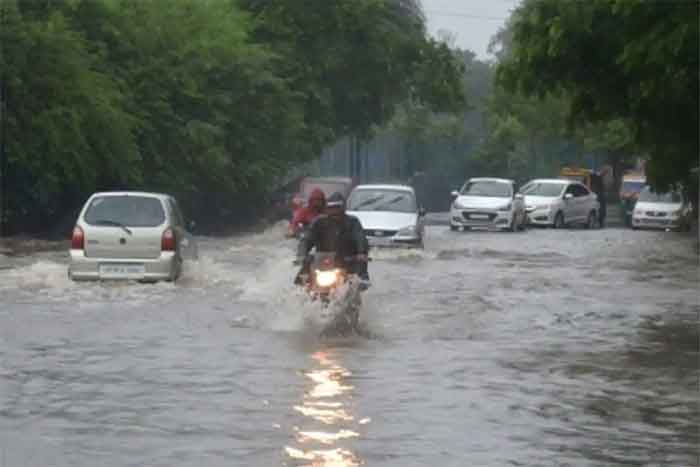
“Each time the rains failed our tubewell came to the rescue. This time the water table went down a lot by the end of May. There was hardly any irrigation possible even for an hour. Due to this the sugarcane crop we had grown in 9 acres turned yellow. It was expected that it would rain from June 5 to 10, but only after June 25, there was some light rain. The ground was so dry that a light rain did not make any difference. Still, the sugarcane crop got some life. But this rain was not suitable for sowing the Kharif crop” says Bhaiya Lal Singh, a farmer of Baghwad village of Betul district complaining about the unpredictable monsoon.
And when it started raining finally on 1st July it poured without stopping, damaging the standing sugarcane crop. The delayed onset of the monsoon, followed by excessive rains, made it virtually impossible for thousands of farmers like Bhaiya Lal to plan the rotation of their crops.
He does not know the concept of global warming but from experience see there is something deeply wrong with the climate. At least it is no longer like it used to be for so many decades he has been a farmer. Typically according to Bhaiya Lal, recalling a 20-year period, it usually started raining around 5th June and continued till later allowing farmers to start sowing their kharif crops early. The rains usually continued till the month of September, when the crops were ripe and sometimes they were affected too but there were also benefits. The long spell of rain ensured there was no shortage of water in summer. Nowadays the rain started late and stopped early – affecting the lives of farmers across Madhya Pradesh and beyond.
Normally till June 28, MP used to receive about 120 mm of rain, but this year only 90 mm was received, a shortfall of 24 percent. The rain that was received was also not uniform across districts, with most parts of eastern MP remaining completely dry. The farmers who had sown Kharif in the first week of June expecting some rain lost their seeds and those with standing crops from before are worried about the incessant rains that started in early July.
As the globe is heating up, India’s monsoon rain patterns are changing. Experts predict that if the globe warms further, there is a chance that even the monsoon wind cycle could be switched off
During the last decade, the country witnessed very erratic monsoon seasons affecting the farming system. The monsoon rains are no longer reliable for farming. If it is heavy rain and flooding in one season, it is drought in another season, a dramatic shift in pattern that is affecting food production and security
 Due to the intense heat this summer farmers expect a 40 percent drop in production of wheat, forcing the Indian government to panic and abruptly ban exports of the commodity in mid-May. Just a week before that India had claimed it had enough stocks of the commodity to ‘feed the world’, in the face of global shortages expected due to the Russia-Ukraine conflict.
Due to the intense heat this summer farmers expect a 40 percent drop in production of wheat, forcing the Indian government to panic and abruptly ban exports of the commodity in mid-May. Just a week before that India had claimed it had enough stocks of the commodity to ‘feed the world’, in the face of global shortages expected due to the Russia-Ukraine conflict.
“Farmers are facing huge losses due to the changes in the monsoon cycle’ says Rajkumar Sinha, a farmer who follows meteorological information closely. He says that the longer farmers delay in understanding how climate is changing, the more damage they will have to suffer. He is among those farmers who have raised their voice against large-scale tampering with nature through urbanisation and industrialisation.
Already, due to late monsoon, the kharif sowing has been affected across MP. By the end of June, kharif crops were to be sown in more than 13 lakh hectares – going by the record from previous years. However, this year this has happened only in 9.25 lakh hectares. Farmers want to sow, but they are not getting a favourable environment.
Manoj Singh Pal, a farmer of Harda district, says that he had sown 2 quintals of soybean seed in a 5-acre field by June 12, which got spoiled because there was no rain on time. According to him the field should not remain empty, so he has to sow again after taking a loan. He says that he has suffered a loss of 12 to 15 thousand rupees per acre, including the cost of seeds. He is worried about what will happen next.
Raghunath, a farmer of Navegaon in Chhindwara, says that the maize crop was sown, which did not grow due to low rainfall. There has been a loss of Rs 15,000 per acre. Bhagat Singh Kushwaha, a farmer from Guna, says that his area is also receiving unusual rainfall. Farmers who have irrigation facilities save their crop by sowing on time. Those who do not have the means of irrigation are in trouble. Paddy was to be planted, which has not been done yet because there has been no good rain.
Balram Yadav, a farmer of Chhatarpur, says that there was light rain. It was not fit to sow. Now that the rain has started it refuses to stop, which is essential for the farmer to be able to sow the seeds. Otherwise the fields will remain empty. Had he sowed earlier too, there would have been a loss.
Even a 2°C rise in the world’s average temperatures will make India’s summer monsoon highly unpredictable according to a World Bank study[1]. At 4°C warming, an extremely wet monsoon that currently has a chance of occurring only once in 100 years, is projected to occur every 10 years by the end of the century. An abrupt change in the monsoon could precipitate a major crisis, triggering more frequent droughts as well as greater flooding in large parts of India.
According to a new assessment report by the Intergovernmental Panel on Climate Change (IPCC) India’s rice production may decrease 30 per cent instead of 10 per cent if global warming over pre-industrial levels rises to 4°C from 1°C. Maize production will decrease 70 per cent instead of 25 per cent in this scenario[2].
Pooja Yadav is a researcher based in Bhopal, Madhya Pradesh
[1] https://www.worldbank.org/en/news/feature/2013/06/19/india-climate-change-impacts
[2] https://www.downtoearth.org.in/news/climate-change/climate-change-induced-droughts-major-driver-of-food-insecurity-ipcc-report-81741#:~:text=In%20India%2C%20rice%20production%20may,per%20cent%20in%20this%20scenario.












































